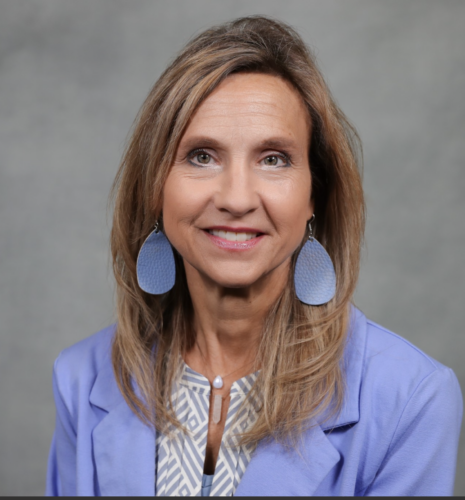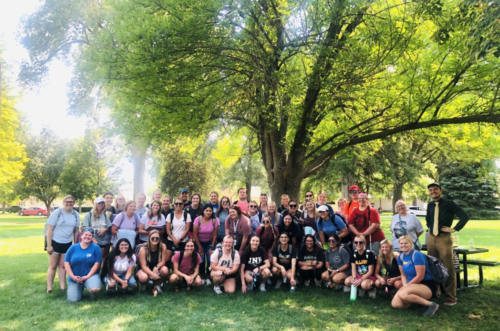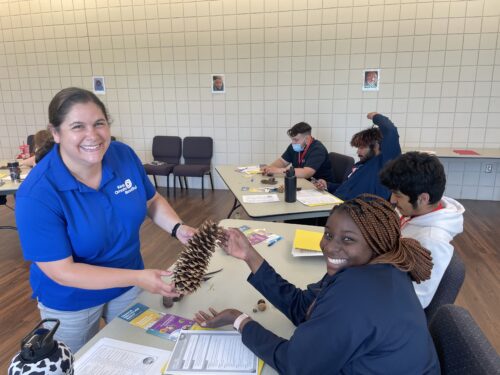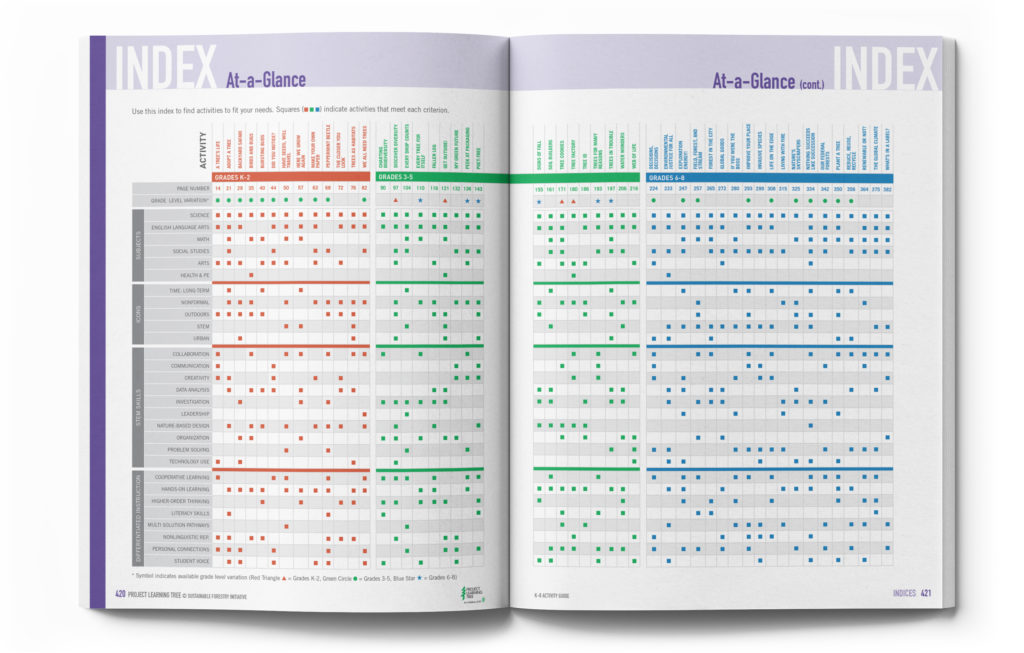March 28, 2024
If you’ve ever been to an in-person PLT professional development event, you’ve been lucky enough to meet some incredible individuals who are passionate about training educators, advancing environmental education, and having a lot of fun with PLT activities! Our PLT facilitators love sharing their wealth of knowledge, tips and tricks for leading nature-based activities, and inspiring educators to incorporate PLT lessons into their classrooms and programs.
This Earth Month, in our People of PLT feature, we’re celebrating not one, but two amazing PLT facilitators from Nebraska whose enthusiasm for environmental education is visible to all who work with them.
Meet Dena Harshbarger, Ph.D., PLT Facilitator & Professor at University of Nebraska, Kearney, College of Education
 Before she began fostering the next generation of teachers, Dena Harshbarger, Ph.D., spent 18 years in the classroom as a 4th and 6th grade teacher. Today, Dena is a professor at the University of Nebraska, Kearney (UNK), where she teaches elementary education methods courses to preservice teachers. She loves sharing her passion for teaching and classroom experience with her students, so much so that last year the Nebraska State Forest Service honored her for her dedication to environmental education!
Before she began fostering the next generation of teachers, Dena Harshbarger, Ph.D., spent 18 years in the classroom as a 4th and 6th grade teacher. Today, Dena is a professor at the University of Nebraska, Kearney (UNK), where she teaches elementary education methods courses to preservice teachers. She loves sharing her passion for teaching and classroom experience with her students, so much so that last year the Nebraska State Forest Service honored her for her dedication to environmental education!
In 2022, Dena became a PLT Facilitator after Jack Hilgert, Nebraska PLT State Coordinator, reached out to her about offering a workshop for her elementary science methods students. “I was trained in Project WILD and Project WET when I was an undergraduate student at UNK in 1992. As a result, I have always been an advocate for environmental education and using the outdoors as an extension of the classroom.”
Incorporating PLT into her preservice coursework was a natural fit. “I strive to find ways to create inquiry-based learning opportunities in which students can discover and ponder the world around us. PLT perfectly aligns with my focus on constructivism and experiential learning. I enjoy getting UNK preservice teachers excited about using PLT in their future classroom.” In fact, Dena’s favorite days are when she sees her preservice students teach elementary students during their field experiences. It brings her back to her classroom days and fills her with pride seeing these future teachers in action – “It’s a full circle moment for me.”

One of the things Dena loves most about PLT is how engaged students (including her preservice teachers) are during activities. Her favorite PLT activity is Every Tree for Itself from the Explore Your Environment: K-8 Activity Guide. “The students are physically and mentally engaged in the lesson as they actively discover how available resources impact a tree’s growth and survival rate. This type of multimodal learning opportunity deepens students’ understanding and increases recall and retention.”
“Today, many children spend less time outdoors and have a more sedentary lifestyle. My goal for elementary and UNK students alike is to gain background knowledge through experiential learning, so they are informed citizens. PLT provides opportunities in which PreK-12 students can explore the world around them and develop an appreciation of nature.” By training future teachers how to use PLT, Dena hopes that when they do enter the classroom, they’ll feel comfortable using nature as a tool to teach about multiple subjects, know how to create safe spaces to teach outdoors, and be more inclined to use PLT in their lessons.
Meet Hannah Rennard-Ganley, PLT Facilitator & Director of Education and Outreach at Keep Omaha Beautiful
 As the Director of Education and Outreach at Keep Omaha Beautiful, Hannah Rennard-Ganley teaches educators how to engage students in urban nature. “I love helping people understand that nature exists within the city, how people are part of that ecosystem, and how they can help improve the environment starting right in their own backyard (or schoolyard, business, park, playground)!”
As the Director of Education and Outreach at Keep Omaha Beautiful, Hannah Rennard-Ganley teaches educators how to engage students in urban nature. “I love helping people understand that nature exists within the city, how people are part of that ecosystem, and how they can help improve the environment starting right in their own backyard (or schoolyard, business, park, playground)!”
Hannah’s long-time love of all things PLT began nearly two decades ago when she became a facilitator in 2007 (or according to her “a million years ago and 10,000 jobs ago”!). She’s led PLT professional development events in Missouri, Illinois, and now Nebraska. It’s her goal to connect educators to great resources, like PLT, that can be used in formal and informal settings.
“I became a facilitator because I’m passionate about providing great resources to educators, and PLT is a great resource for educators in both informal and formal educational settings. I like empowering educators to feel comfortable teaching about the environment. So often people forget about the urban forest when they are teaching kids about nature. Facilitating workshops for educators allows me to help educators look at the nature within the city in a new way – the whole world outside becomes their classroom – while also providing hands-on, relevant activities.”
Like Dena, Hannah loves just how engaging and fun PLT activities are. Here are her top three favorite activities:
- Bursting Buds from Explore Your Environment | “I like Bursting Buds because it can be done at so many different levels. Little kids can understand the parts of a tree and spring renewal from the observations, and older students can learn the anatomy of a tree and participate in detailed dissection.”
- The Shape of Things from Trees & Me: Activities for Exploring Nature with Young Children | “Going for a shape walk forces students to slow down and make observations of the world around them. It can also be repeated many times, and kids observe different things each time they do it. And the leaf dance makes everyone laugh!”
- Parts to Play from Trees & Me | Hannah thinks the Tree Costumes activity, where children dress like a tree, is fantastic. “Any time you get little kids to dress in costume, they learn so much and have a blast. I really enjoy making Kindergarten ‘forests’!”
Tips for Getting Started with PLT Lessons
When it comes to training current and future educators, there is a delicate balance of teaching to state and national standards and also keeping students with differing backgrounds and abilities engaged with what they’re learning. There are multiple competing priorities for educators today that Dena frequently hears: “I don’t have time to do PLT” or “How do educators use PLT if they are obligated to teach to the fidelity of their program?”.

Dena says, “PLT does not need to be an “add-on” to your existing curriculum. The PLT lessons include cross-curricular components that potentially deepen understanding and make concepts applicable to real-world phenomena. Finding time to weave a PLT lesson into your existing curriculum or standards-based instruction will potentially accomplish many learning objectives with one lesson. Students can read, write, and discuss environmental concepts in a meaningful way.”
Both Hannah and Dena recommend starting small.
Dena suggests selecting “one or two lessons that would work well with your goals/learning objectives.” Plus, she shares how you can adapt and break apart activities into short and easy-to-implement formats. Hannah agrees. “Don’t be afraid to fit PLT into the time you have. I have built whole semester long units around PLT activities. I’ve also used a fraction of an activity for a quick 15-minute “brain break” during other educational programs. One of the fantastic things about PLT is that there is such a variety in the activities that you can make it fit the time you have.”
Sometimes, educators worry about taking students outside for lessons. Dena recommends you “explicitly teach and model expectations for outdoor activities prior to going out or distributing materials.” Setting expectations up front helps set the stage for success.
Always Be Learning
The beauty of PLT’s professional development is that you’re not only learning how to use nature to teach, but you can be inspired by other educators. Hannah says, “Take as many classes as you can! I am super familiar with PLT curriculum and activities, but I LOVE watching how other people teach them. I feel like I learn something new every time I see someone teach. And when I take classes, I participate in activities that I don’t always teach so it opens up new options.”
But most of all, Dena says, “Get excited and enjoy watching the students get excited about learning using this ‘TREE’-mendous resource and program!”
Ways to Get Involved with PLT
Educator Professional Development: If you’re interested in taking a PLT professional development course, check out events happening near you.
Preservice/Higher Education: PLT is an amazing resource for those working with preservice teachers and natural resource students. Contact your PLT State Coordinator to bring PLT into your preservice or higher education program.
Become a PLT Facilitator: We’re always looking for individuals who want to share their passion for PLT and environmental education with others! Connect with your PLT State Coordinator to learn more about becoming a PLT workshop facilitator.


